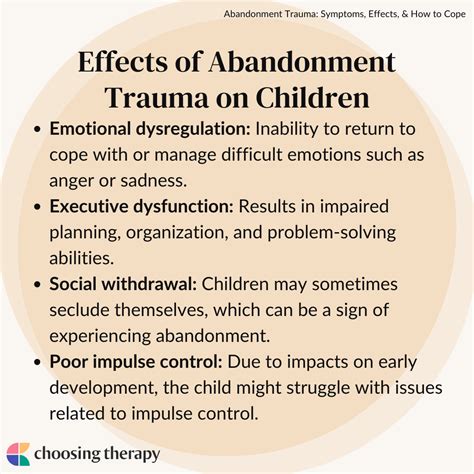
Many adults unknowingly carry the weight of childhood trauma, manifesting as a deep-seated fear of abandonment that subtly influences their relationships and behaviors, according to experts. These ingrained patterns, often stemming from experiences like neglect, emotional unavailability, or parental loss, can lead to anxiety, insecurity, and difficulty forming secure attachments in adulthood.
The lingering effects of childhood trauma can be pervasive, shaping how individuals perceive themselves and interact with others. Psychologists emphasize that recognizing these patterns is the first step toward healing and developing healthier coping mechanisms. “Unresolved childhood trauma can manifest in various ways, including difficulty trusting others, a constant need for reassurance, and a tendency to sabotage relationships,” explains Dr. Elena Santos, a clinical psychologist specializing in attachment theory. “These behaviors are often unconscious attempts to manage the fear of abandonment, but they can inadvertently push people away.”
One of the most common manifestations of this fear is anxious attachment style, characterized by a persistent worry about the availability and responsiveness of partners. Individuals with this attachment style may exhibit clingy behavior, excessive jealousy, and a heightened sensitivity to perceived rejection. “They might constantly seek reassurance from their partner, fearing that any sign of distance or disagreement indicates impending abandonment,” says relationship therapist Sarah Chen. “This can create a self-fulfilling prophecy, where their anxiety ultimately strains the relationship.”
Conversely, some individuals develop an avoidant attachment style as a defense mechanism against potential hurt. They may suppress their emotions, avoid intimacy, and maintain a sense of independence to protect themselves from the vulnerability of relying on others. “Avoidant individuals often struggle with commitment and may prioritize their own needs and autonomy above the needs of their partner,” explains Dr. Santos. “This can lead to emotional distance and difficulty forming deep, meaningful connections.”
Other behavioral patterns indicative of a fear of abandonment include:
- People-pleasing: A constant need to please others, often at the expense of one’s own needs and boundaries, in an attempt to secure approval and avoid rejection.
- Difficulty setting boundaries: A struggle to assert one’s needs and limits, fearing that doing so will lead to abandonment or disapproval.
- Overthinking and rumination: A tendency to obsessively analyze interactions and relationships, searching for signs of potential abandonment.
- Sabotaging relationships: Unconsciously engaging in behaviors that undermine relationships, such as pushing partners away or creating conflict, as a preemptive defense against perceived abandonment.
- Staying in unhealthy relationships: Tolerating mistreatment or staying in relationships that are not fulfilling, fearing that leaving will result in being alone.
- Extreme reactions to perceived slights: Overreacting to minor disagreements or perceived rejections, interpreting them as evidence of impending abandonment.
- Constant need for validation: Seeking external validation from others to feel worthy and secure, relying on others’ approval to regulate self-esteem.
- Difficulty being alone: Experiencing anxiety and discomfort when alone, fearing that being alone equates to being unloved or unwanted.
- Jealousy and possessiveness: Exhibiting excessive jealousy and possessiveness in relationships, fearing that the partner will leave for someone else.
- Difficulty trusting others: Having a general distrust of others, fearing that they will eventually betray or abandon them.
The roots of these behaviors often lie in specific childhood experiences, such as:
- Neglect: Experiencing a lack of emotional or physical care from parents or caregivers, leading to a sense of unworthiness and abandonment.
- Emotional unavailability: Having parents who were emotionally distant, unresponsive, or unable to provide emotional support, creating a sense of emotional abandonment.
- Parental loss: Experiencing the death or abandonment of a parent, leading to a deep-seated fear of loss and abandonment.
- Inconsistent parenting: Receiving inconsistent or unpredictable care from parents, creating a sense of insecurity and uncertainty about their love and support.
- Abuse: Experiencing physical, emotional, or sexual abuse, leading to trauma and a fear of being harmed or abandoned.
- Witnessing domestic violence: Witnessing violence between parents or caregivers, creating a sense of fear and instability.
- Having a parent with mental illness or addiction: Growing up with a parent who struggled with mental illness or addiction, leading to neglect, inconsistency, and emotional distress.
- Being criticized or belittled: Experiencing constant criticism or belittlement from parents or caregivers, leading to low self-esteem and a fear of rejection.
- Feeling unheard or unseen: Feeling like one’s thoughts and feelings were not valued or acknowledged by parents or caregivers, leading to a sense of invisibility and unimportance.
- Parental divorce or separation: Experiencing the divorce or separation of parents, leading to feelings of instability and abandonment, especially if the child felt responsible.
Addressing the fear of abandonment requires a multi-faceted approach that includes self-awareness, therapy, and the development of healthier coping mechanisms. “The first step is recognizing that these patterns are rooted in childhood trauma and are not a reflection of one’s inherent worth,” says Chen. “Therapy, particularly attachment-based therapy, can help individuals explore their past experiences, understand how they have shaped their current behaviors, and develop healthier ways of relating to others.”
Cognitive behavioral therapy (CBT) can also be beneficial in challenging negative thought patterns and developing more realistic and positive self-perceptions. Dialectical behavior therapy (DBT) can help individuals regulate their emotions, improve their interpersonal skills, and tolerate distress. Eye Movement Desensitization and Reprocessing (EMDR) is another therapeutic approach that can be effective in processing traumatic memories and reducing their emotional impact.
In addition to therapy, practicing self-compassion is crucial. “Treating yourself with kindness and understanding, especially during times of vulnerability, can help to heal the wounds of the past and build a stronger sense of self-worth,” explains Dr. Santos. “It’s important to remember that you are not defined by your past experiences and that you have the capacity to create a more fulfilling and secure future.”
Developing healthy coping mechanisms, such as mindfulness, exercise, and spending time in nature, can also help to manage anxiety and regulate emotions. Building a strong support system of friends, family, or support groups can provide a sense of belonging and reduce feelings of isolation. Learning to set healthy boundaries and assert one’s needs can empower individuals to protect themselves from further hurt and build healthier relationships.
Ultimately, overcoming the fear of abandonment is a journey of self-discovery and healing. It requires courage, vulnerability, and a commitment to breaking free from the patterns of the past. With the right support and tools, individuals can create a more secure and fulfilling future, free from the grip of childhood trauma.
The impact of childhood trauma can extend far beyond the individual, affecting their relationships, career, and overall well-being. Understanding the signs and seeking appropriate help is essential for breaking the cycle of trauma and creating a healthier future for oneself and future generations. The journey may be challenging, but the rewards of healing and developing secure attachments are immeasurable.
Expanded Context and Deeper Analysis
The pervasive nature of childhood trauma and its manifestation as a fear of abandonment highlights the critical importance of early childhood experiences in shaping adult mental health. Attachment theory, developed by John Bowlby and Mary Ainsworth, provides a framework for understanding how early interactions with caregivers influence an individual’s ability to form secure attachments in adulthood. Secure attachment, characterized by trust, intimacy, and emotional stability, is fostered when caregivers are consistently responsive, attuned, and available to meet the child’s needs. Conversely, insecure attachment styles, such as anxious and avoidant attachment, develop when caregivers are inconsistent, neglectful, or emotionally unavailable.
The fear of abandonment, often rooted in insecure attachment, can manifest in a variety of ways, impacting an individual’s relationships, career, and overall well-being. In relationships, it can lead to clingy behavior, jealousy, difficulty trusting partners, and a tendency to sabotage relationships. In the workplace, it can manifest as people-pleasing, difficulty setting boundaries, and a fear of rejection or criticism. In general, it can contribute to anxiety, depression, low self-esteem, and a sense of unworthiness.
The impact of childhood trauma can be compounded by factors such as socioeconomic status, cultural background, and access to mental health care. Individuals from disadvantaged backgrounds may face additional stressors that exacerbate the effects of trauma, such as poverty, discrimination, and violence. Cultural norms and beliefs can also influence how trauma is experienced and expressed, as well as the availability of culturally sensitive mental health services.
Addressing childhood trauma and the fear of abandonment requires a comprehensive and integrated approach that includes prevention, early intervention, and treatment. Prevention efforts should focus on promoting positive parenting practices, providing support to families in need, and creating safe and nurturing environments for children. Early intervention programs can help to identify children who are at risk of developing mental health problems due to trauma and provide them with timely and appropriate support. Treatment options include therapy, medication, and support groups.
The role of society in addressing childhood trauma is also crucial. Schools, community organizations, and government agencies can play a vital role in raising awareness about the impact of trauma, providing training to professionals who work with children and families, and advocating for policies that support the well-being of children. Creating a trauma-informed society, where individuals are aware of the impact of trauma and respond in a compassionate and supportive way, is essential for promoting healing and preventing future trauma.
The long-term consequences of unresolved childhood trauma can be significant, affecting not only the individual but also their families and communities. Breaking the cycle of trauma requires a collective effort from individuals, families, communities, and society as a whole. By understanding the signs of childhood trauma, seeking appropriate help, and creating a trauma-informed society, we can create a brighter and more secure future for all.
Moreover, the concept of intergenerational trauma further complicates the landscape. This refers to the transmission of trauma’s effects across generations, where the unresolved trauma of parents or grandparents can influence the emotional and behavioral patterns of subsequent generations. For instance, a parent who experienced neglect in their childhood may unconsciously replicate those patterns with their own children, perpetuating a cycle of insecurity and fear of abandonment. Recognizing and addressing intergenerational trauma is crucial for breaking these cycles and promoting healing across families.
The stigma surrounding mental health can also be a significant barrier to seeking help for childhood trauma. Many individuals may feel ashamed or embarrassed to admit that they are struggling with the effects of trauma, fearing judgment or discrimination. Overcoming this stigma requires education, awareness, and open conversations about mental health. Creating a safe and supportive environment where individuals feel comfortable sharing their experiences is essential for encouraging help-seeking behavior.
Furthermore, the intersection of trauma with other social and systemic issues, such as poverty, racism, and discrimination, can create additional challenges for individuals seeking healing. These factors can exacerbate the effects of trauma and create barriers to accessing mental health services. Addressing these systemic issues is crucial for creating a more equitable and just society where all individuals have the opportunity to heal and thrive.
Frequently Asked Questions (FAQ)
Q1: What are the main signs that I might have a fear of abandonment rooted in childhood trauma?
A: Signs can include an anxious or avoidant attachment style, people-pleasing behavior, difficulty setting boundaries, overthinking and rumination about relationships, sabotaging relationships, staying in unhealthy relationships, extreme reactions to perceived slights, a constant need for validation, difficulty being alone, jealousy and possessiveness, and difficulty trusting others. These behaviors often stem from experiences like neglect, emotional unavailability, or parental loss in childhood.
Q2: What types of childhood experiences can lead to a fear of abandonment?
A: Experiences that can contribute to a fear of abandonment include neglect (emotional or physical), emotional unavailability of parents, parental loss (through death or abandonment), inconsistent parenting, abuse (physical, emotional, or sexual), witnessing domestic violence, having a parent with mental illness or addiction, being criticized or belittled, feeling unheard or unseen, and parental divorce or separation.
Q3: How can therapy help me overcome my fear of abandonment?
A: Therapy, particularly attachment-based therapy, can help you explore your past experiences, understand how they have shaped your current behaviors, and develop healthier ways of relating to others. Cognitive behavioral therapy (CBT) can challenge negative thought patterns, while dialectical behavior therapy (DBT) can help regulate emotions and improve interpersonal skills. EMDR can process traumatic memories.
Q4: Besides therapy, what are some other strategies I can use to cope with my fear of abandonment?
A: Practicing self-compassion, developing healthy coping mechanisms like mindfulness and exercise, building a strong support system, learning to set healthy boundaries, and asserting your needs can all be helpful. It’s important to remember that you are not defined by your past experiences and that you have the capacity to create a more fulfilling and secure future.
Q5: How do I find a therapist who specializes in childhood trauma and attachment issues?
A: You can start by asking your primary care physician for a referral. You can also search online directories of therapists, such as those provided by the American Psychological Association (APA) or the American Association for Marriage and Family Therapy (AAMFT). When searching, look for therapists who specialize in trauma, attachment theory, and related issues. It’s also important to find a therapist with whom you feel comfortable and safe. Don’t hesitate to interview potential therapists before committing to treatment.
The journey of addressing childhood trauma and the resulting fear of abandonment is a deeply personal and often challenging one. It requires a willingness to confront painful memories and patterns, a commitment to self-compassion, and the courage to seek help and support. While the process may be difficult, the rewards of healing and developing secure attachments are immeasurable, leading to greater emotional well-being, healthier relationships, and a more fulfilling life. Remember that you are not alone, and help is available.









